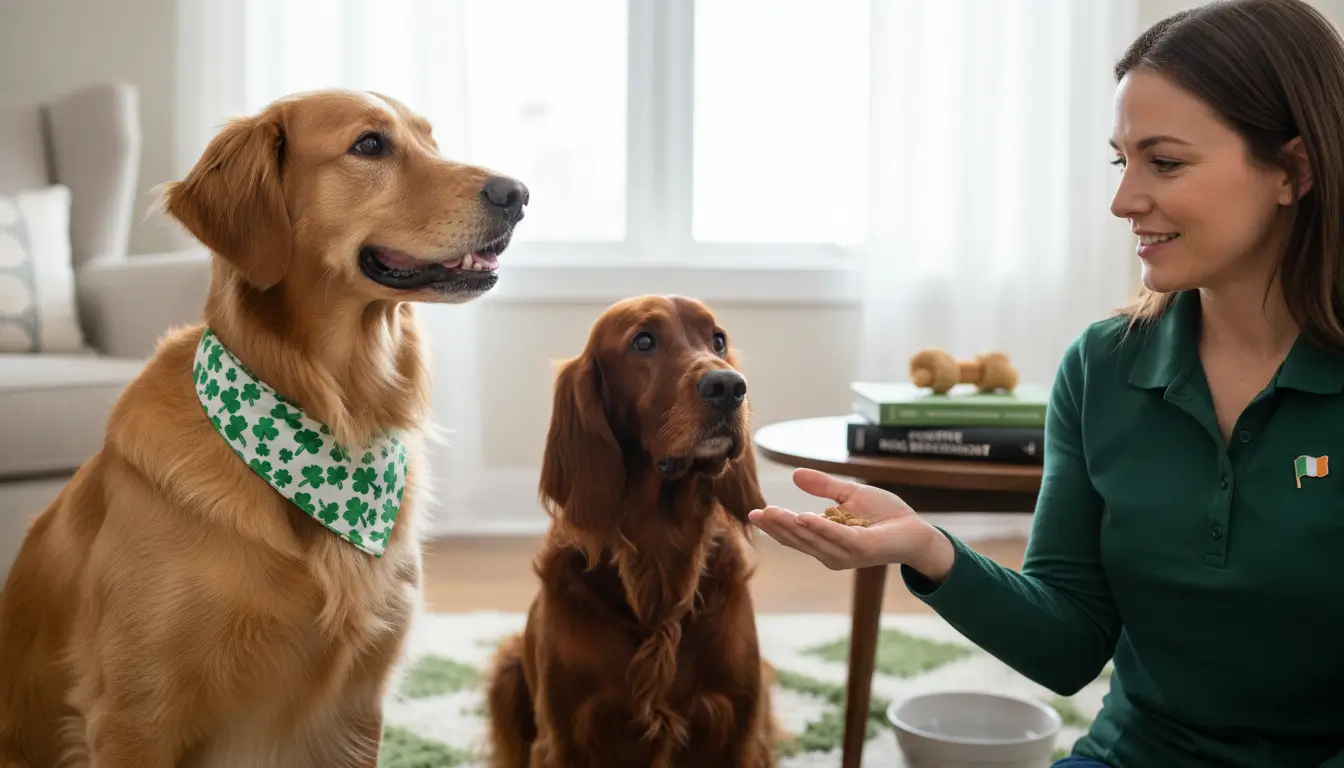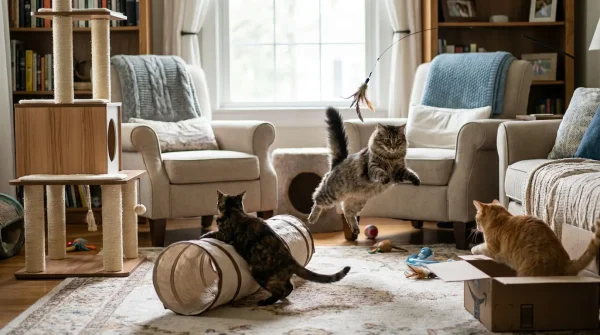Expert Dog Training Tips: A Complete Guide for Irish Pet Owners
Introduction to Modern Dog Training Methods
Training your dog is one of the most rewarding investments you can make in your relationship with your canine companion. Modern dog training methods focus on positive reinforcement, mutual respect, and building a strong bond between you and your dog. Whether you’ve just welcomed a new puppy to your family or you’re working with an older dog who needs some guidance, understanding effective training principles can transform your daily life.
This comprehensive guide covers the most effective dog training tips and techniques proven to work for Irish pet owners. We’ll explore everything from basic obedience commands to advanced training methods, always focusing on positive, force-free approaches that respect your dog’s natural instincts and learning styles.
Why Positive Reinforcement Training Works Best
Modern veterinary behaviorists and professional trainers overwhelmingly recommend positive reinforcement training. This approach rewards desired behaviors rather than punishing unwanted ones. Here’s why it works so effectively:

The Science Behind Positive Training
Dogs are social animals who naturally seek to please their human companions. When training methods focus on rewarding good behavior with treats, praise, toys, or play, dogs become eager participants in their own learning process. Studies show that dogs trained with positive methods learn faster, retain behaviors longer, and develop stronger bonds with their owners.
Conversely, punitive training methods (like leash corrections, shouting, or physical punishment) can create fear, anxiety, and behavioral problems. These approaches may suppress unwanted behaviors temporarily but often damage the human-animal bond and can lead to aggression.
Getting Started with Positive Training
To begin positive training, you’ll need:
- High-value treats: Small, soft treats your dog loves (chicken pieces, cheese cubes, or commercial training treats)
- A marker signal: A clicker or a consistent verbal marker like “Yes!” or “Good!”
- Patience and consistency: Dogs learn best with short, frequent training sessions
- Timing: Reward behaviors immediately (within 1-2 seconds)
Essential Dog Training Tips for Irish Pet Owners
1. Start Training Early (But It’s Never Too Late)
Puppies begin learning from the moment they’re born. While formal training can start around 8-12 weeks of age, early socialization and gentle training should begin immediately. Puppy classes are excellent for this stage, providing both training and crucial socialization experiences.
However, if you’re working with an adult dog or rescue, remember: it’s never too late to start training. Adult dogs can learn just as effectively as puppies, sometimes even more quickly since they have better impulse control.
2. Keep Training Sessions Short and Fun
Dogs have short attention spans. Aim for 5-10 minute training sessions, 2-3 times daily. End each session on a positive note, even if it means asking for an easy behavior your dog already knows. This keeps training enjoyable and prevents frustration for both you and your dog.
3. Use High-Value Rewards for Difficult Behaviors
Not all treats are created equal. Use ordinary kibble for easy behaviors your dog knows well, but save the high-value rewards (like tiny pieces of chicken, cheese, or specially-purchased training treats) for:
- Learning new behaviors
- Training in distracting environments
- Working on challenging behaviors
- Recall training (coming when called)
Remember, rewards don’t always have to be food. Many dogs are motivated by play, praise, or toys. Discover what your dog values most and use it strategically.
4. Be Consistent in Your Commands and Rules
Consistency is crucial for effective dog training tips. Use the same word cues for commands, and ensure all family members use identical commands and rules. If “down” means lie down, don’t use “get down” for jumping up. If your dog isn’t allowed on the sofa, everyone in the household must enforce this rule consistently.
Inconsistency confuses dogs and slows learning. Create a family training plan so everyone uses the same methods and commands.
5. Master the Art of Timing
Timing is everything in dog training. You have about 1-2 seconds to mark and reward a behavior for your dog to make the connection. This is where a clicker or marker word becomes invaluable. Click the moment your dog performs the desired behavior, then follow with a treat within 2-3 seconds.
Poor timing can accidentally reward the wrong behavior, so practice your timing skills to improve training efficiency.
Step-by-Step Training for Essential Commands
Teaching “Sit” – The Foundation Behavior
“Sit” is one of the easiest behaviors to teach and serves as a foundation for other training:
- Hold a treat just above your dog’s nose
- Slowly move the treat back over their head
- As their head tilts up, their bottom will naturally lower
- The moment their bottom touches the ground, say “Yes!” and give the treat
- Repeat 10-15 times in short sessions
- Once reliable, add the verbal cue “Sit” just before you lure
- Gradually fade the food lure, using only your hand signal
Practice in different locations with increasing distractions. A reliable sit is invaluable for managing your dog in various situations.
Teaching “Stay” – Building Duration and Distance
Once “sit” is reliable, teach “stay”:
- Ask your dog to sit
- Hold your palm facing them like a stop signal
- Say “Stay” in a calm voice
- Take one step back, then immediately return and reward
- Gradually increase distance and duration
Critical tip: Always return to your dog to reward them for staying, rather than calling them to you. This teaches them to remain in place until released.
Teaching “Come” (Recall) – The Lifesaving Command
Reliable recall is arguably the most important behavior for safety. Here’s how to train it:
- Start indoors in a low-distraction environment
- When your dog is nearby, say their name enthusiastically, followed by “Come!”
- As they turn toward you, crouch down and open your arms invitingly
- The moment they reach you, give a super high-value reward (several treats, excited praise, play)
- Let them go back to what they were doing (don’t grab them)
Never punish a dog who comes to you, even if they were slow or you had to call multiple times. Coming to you should always result in wonderful things.
Practice with a long training lead (10-30 meters) outdoors before expecting off-leash reliability. Irish dog parks and secure training fields are perfect for this practice.
Teaching “Leave It” – Impulse Control and Safety
This essential cue prevents your dog from picking up dangerous or undesirable items:
- Hold a treat in a closed fist
- Let your dog investigate your fist (sniff, lick, paw)
- Wait until they look away (even slightly)
- Immediately say “Yes!” and give the treat from your other hand
- Repeat until your dog immediately ignores your hand when you say “Leave it”
- Progress to open hand, then treats on the floor
“Leave it” can prevent your dog from eating something toxic or picking up dangerous objects on walks.
Teaching Loose-Leash Walking
Many Irish dog owners struggle with dogs who pull on leash. Traditional “heel” training often fails because it requires constant attention from the dog. Instead, teach loose-leash walking:
- Use a front-clip harness or regular collar (never choke or prong collars)
- Start in a quiet area with minimal distractions
- Begin walking, holding the leash loosely
- If your dog moves ahead and the leash tightens, immediately stop and stand still
- Call your dog back or wait for them to return to your side
- When they return, resume walking, praising calm walking by your side
This method teaches dogs that pulling stops the walk, while slack leash allows forward movement. Be patient—progress can be slow at first, but consistency pays off.
Advanced Dog Training Tips for Challenging Behaviors
Addressing Barking Excessively
Many dogs bark at doorbells, other dogs, or for attention. To reduce problematic barking:

- Attention barking: Completely ignore (no eye contact, no speaking). Reward quiet behavior with treats and attention
- Alarm barking: Teach a “Quiet” cue by waiting for a pause in barking, saying “Quiet,” then immediately treating
- Reactivity barking: Increase distance from triggers and reward calm behavior
Never yell at a barking dog—it often sounds like you’re joining in!
Preventing and Managing Jumping Up
Jumping is a natural greeting behavior, but it’s problematic for many owners and visitors:
- Ignore the jumping completely (turn your back, no eye contact, no talking)
- When your dog has four feet on the floor, immediately reward
- Teach an alternative greeting behavior, like “sit for greetings”
- Practice with friends and family entering your home
- Keep a leash on your dog indoors during training to manage jumping
Consistency from all visitors is essential for success.
Dealing with Separation Anxiety
Separation anxiety is distressingly common in Irish dogs. Symptoms include destructive behavior, excessive vocalization, and house soiling when left alone. While severe cases require veterinary behaviorist intervention, you can help with these steps:
- Practice departures: Pick up keys, put on shoes, then don’t leave—break the anxiety pattern
- Gradual departures: Leave for 5 seconds, return calmly, gradually increase duration
- Provide enrichment: Puzzle toys, frozen Kongs, or long-lasting chews
- Stay calm: Avoid dramatic hellos and goodbyes
- Create positive associations: Give special treats only when you’re leaving
For severe cases, consult a certified veterinary behaviorist. This is a medical issue requiring professional help.
The Importance of Socialization in Training
Socialization means exposing your dog to various people, animals, environments, and experiences in a positive way. The critical socialization period ends around 12-16 weeks, but socialization continues throughout life.
Safe Socialization in Ireland
Ireland offers numerous opportunities for dog socialization:
- Puppy classes: Look for force-free, positive reinforcement-based classes
- Organized dog walks: Many towns have dog walking groups
- Pet-friendly businesses: Increasingly common in Irish towns
- Beach walks: Great for socialization (check seasonal dog restrictions)
- Training classes: Excellent for ongoing socialization
Important: Ensure all experiences are positive. If your dog seems stressed or overwhelmed, increase distance and reward calm behavior.
Training Specific to Irish Dog Owners
Living in Ireland presents unique training opportunities and challenges:
Training for Ireland’s Climate
Our famously variable weather means you’ll train in rain, wind, and occasionally sunshine. Use this to your advantage:
- Weatherproof gear (for both you and your dog) makes training more comfortable
- Indoor training stations are useful for particularly wet days
- Muddy conditions provide excellent distraction training opportunities
Understanding Ireland’s Dog Laws
Irish dog law requires all dogs to be under effective control in public spaces. This makes reliable recall and leash manners essential, not optional. Additionally, certain breeds require specific containment measures. Always check local council regulations, as they vary across counties.
Using Ireland’s Natural Resources for Training
Ireland’s landscape offers excellent training environments:
- Beaches provide excellent distraction training (water, other dogs, seabirds)
- Forests and parks offer varied terrain and scents for mental stimulation
- Urban areas provide practice with traffic, crowds, and city distractions
When to Seek Professional Help
While these dog training tips cover the fundamentals, professional guidance is invaluable, especially for:

- Growing training challenges despite consistent practice
- Beyond normal puppy behavior like resource guarding, fear, or aggression
- You need personalized guidance tailored to your specific dog and lifestyle
- Time constraints that make consistent training difficult
- You want to progress to advanced training or dog sports
Look for certified positive reinforcement trainers. Organizations like the Pet Professional Guild of Ireland and the Association of Pet Dog Trainers (APDT) offer directories of qualified trainers committed to force-free methods.
Training Equipment Recommendations
Essential Training Gear
Quality equipment makes training easier and safer:
- Front-clip harness: Prevents pulling without neck strain
- Long training line: 10-30 meters for safe recall practice
- Treat pouch: Easy access to rewards during training
- Clicker or marker word: Clear communication tool
- High-quality treats: Soft, small, and highly motivating
- Interactive toys: Kongs, puzzle toys, and treat-dispensing balls
Avoid: choke chains, prong collars, shock collars, and other aversive equipment. These can cause physical injury and behavioral problems.
Technology-Enhanced Training
Modern technology can support your training:
- Training apps: Track progress and set reminders
- Video recording: Film training sessions to analyze techniques
- Online courses: Access expert guidance from home
Maintaining Training Throughout Your Dog’s Life
Training isn’t a one-time event but a lifelong process. Dogs continue learning throughout their lives, and ongoing training strengthens your bond and keeps behaviors reliable.
Refreshers and Ongoing Practice
Incorporate training into daily life:
- Use sits and stays when preparing meals or getting ready for walks
- Practice recalls during every outing, even when your dog is already coming
- Ask for polite behaviors before giving attention, treats, or play
- Continue attending classes or joining dog activities for ongoing socialization
Ongoing mental stimulation through training prevents boredom and associated behavioral problems.
Conclusion: The Journey of Training
Effective dog training tips focus on communication, mutual respect, and positive reinforcement. Every dog is an individual with unique personalities, motivations, and learning styles. What works brilliantly for one dog may need modification for another.
Training your dog is about building a relationship based on trust and understanding. It’s one of the most meaningful gifts you can give to your canine companion—and to yourself. The skills your dog learns, the bond you build, and the joy of working together will enrich both your lives for years to come.
Remember to celebrate small successes, stay patient during setbacks, and always prioritize your dog’s emotional and physical wellbeing. Training should be fun for both of you!
Ready to start training? Gather your high-value treats, grab a clicker, and begin with just 5 minutes today. Your dog is already learning—make sure they’re learning what you want them to know!





